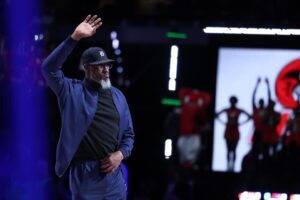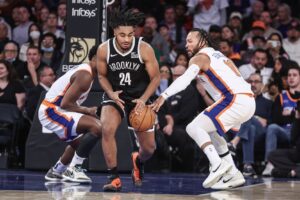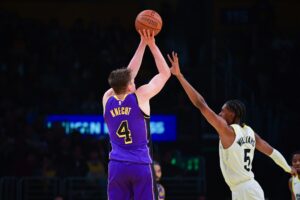When the Oklahoma City Thunder emerged in 2008 after being the Seattle Supersonics, it ushered in an electric, young team that helped create the culture of “Loud City.” Unfortunately, OKC’s nuclear core was broken up and the team didn’t reach the point of winning a Larry O’ Brien trophy.
However, the Thunder was one of the most successful and consistent teams in the 2010s. They’ve made a trip to the 2012 Finals, as well as appearing in the Western Conference Finals four times. OKC is the franchise that they are all thanks to these players, some who transformed into ultimate superstars.
Oklahoma City Thunder 2010s All-Decade Team
Oklahoma City Thunder All-Decade Team Starting Five
Guard: Russell Westbrook
Russell Westbrook no doubt is the one player that truly represents the “Thunder” in the team’s name. For over a decade, Westbrook brought forth so much energy and aggressiveness in his game, making him one of the most electrifying point guards in the past decade.
Numbers-wise, Westbrook didn’t stop or settle to get his by any means necessary. Year after year, he improved not only in scoring but in rebounding and assists as well. This helped lead to a triple-double season run for three straight seasons. In 2016, Russell averaged 34 points, 10 rebounds, and 10 assists, earning him the 2016-17 MVP trophy.
During this run, Westbrook was a clutch scorer and a leader to the younger players, helping them out with their game.
The one thing though that sets Westbrook apart from other OKC players was his loyalty and devotion to Oklahoma City. He remained focused on basketball and doing his best to keep the culture of “Loud City” alive.
Guard: Paul George
Even though Paul George played two seasons in OKC, it helped make George polish all areas of his game.
In the 2018-19 season, George averaged 28 points and 8 assists, shooting 38.6 percent from three-point range. This season brought out the best of Paul George as an overall player. George looked more confident with his shot, as well as in his ability to be the go-to guy in most plays. His career numbers made him an MVP candidate in most people’s eyes.
Forward: Kevin Durant
Despite Kevin Durant‘s departure in 2016 that ruffled many Thunder fans feathers, there’s no denying that Durant is one of the best players in the 2010s and one of the greatest players in Thunder history.
Since his arrival in 2007, Durant became an important part of OKC during this decade with his ability to score. He moves so smoothly on the court, and when he puts up that shot, it’s guaranteed to go in. Durant is arguably one of the most prolific scorers in NBA history and during his time in OKC, he shows that so well in his ability to create shots.
During his time in Oklahoma City, Durant averaged 27.4 points, 7 rebounds, and 3 assists, shooting 48 percent from the field and 38 percent from three-point range. Durant was a player that can give you nearly 30 every night and did so in a flashy way and in a quiet way.
One big moment in Durant’s career as a Thunder was his performance during the 2013-14 season. In the regular season, he averaged 32 points, 5.5 assists, and 7.4 rebounds. Not only did Durant surpass Micheal Jordan‘s record for consecutive games scoring 25+ points (41 games), he also won the 2014 MVP award. Even though his ugly exit made some question his value in Oklahoma City, what was in that city was a lethal scorer that had an extreme impact on OKC’s success.
Forward: Serge Ibaka
In Oklahoma City’s run from 2010-2014 that lead them to the Finals and two Western Conference Finals, Serge Ibaka was a player that made a difference both offensively and defensively. A two-time Blocking Champion and three-time All-Defensive team player, Ibaka was the ultimate rim protector. He blocked as much as three shots a game in 2011 and 2012. His ability to block shots made a difference in OKC winning a game from losing a game, especially in the playoffs.
In 2013 and beyond up until his departure, Ibaka’s blocking numbers decreased to nearly less than two blocks a game. But Ibaka did improve his shooting game, shooting as high as 38 percent from three. What Ibaka did well during his time in OKC was his ability to adapt to the league while also enhancing his skills.
Center: Steven Adams
When drafted in 2012, Steven Adams was brought in to be the main center to blend into OKC’s youth foundation.
Throughout his time at OKC, Adams played his role as a big man once he took the starting spot from Kendrick Perkins in his second season. He can set up screens and finish quickly at the basket. He also is a skilled playmaker that uses all of his body to make plays. In the 2017-18 season, Adams averaged a career-high 13.9 points, shooting 62.9 percent from the field.
Bench
Guard: Reggie Jackson
What helped Reggie Jackson transform himself into a role player was his experiences in OKC. He learned first-hand playing alongside Westbrook, but most importantly when Russell went down in 2013 due to a torn lateral meniscus. This put Jackson in a position to be the primary ball-handler. That didn’t go too well during the 2013 NBA Playoffs, as the Thunder got eliminated by the Memphis Grizzlies, 4-1.
When the Thunder had to face the Grizzlies again in the first round of the 2014 Playoffs, Jackson had a significant impact on that series. In Game Four, Oklahoma City was on the brink of being 4-1 again. But Jackson scored a career-high 32 points, shooting 11 of 16 from the field. He also made all eight of his free throws in the game, which helped OKC tie the series. Jackson averaged 13.1 points and four assists in the 2013-14 season.
Guard: Thabo Sefolosha
When it came to having a player that would fit in the lineup seamlessly, Thabo Sefolosha was one of those players.
Sefolosha was the wing player that OKC needed. He was able to hit the three-ball (35 percent three-point shooting) as well as play stellar on defense, averaging 1.2 steals and nearly a block per game in six seasons with the Oklahoma City Thunder. Given the talent that he was surrounded by, Sefolosha pitched in when needed for the team. He also had a career moment during the 2012 NBA Playoffs against the San Antonio Spurs, where he scored 19 points and had six steals, all while playing 37 minutes. During his time in Oklahoma City, Sefolosha averaged 6.2 points, 1.5 assists, and 4.1 rebounds.
Forward: Andre Roberson
When Andre Roberson arrived in OKC in the 2013-14 season, Sefolosha mentored him to help him be a defensive mastermind for his position. Unlike Sefolosha, Roberson was not the best shooter from beyond the arc (25 percent career shooter).
But Roberson quickly learned how to be that defensive mastermind, as he knows how to use his hands and his entire body to guard even the most elite shooters, like Klay Thompson. In five seasons with the Thunder, Roberson averaged 4.6 points, three assists, 0.9 steals and 0.7 blocks.
Forward: Nick Collison
Also known as “Mr. Thunder”, Nick Collison has been through it all, as an Oklahoma City Thunder and Seattle Supersonic. Collison has spent his entire 14-year career with the team, averaging 5.9 points, 5.2 rebounds, and 1.2 assists.
Collison was not a player that would give you double-doubles every night. But, Collison was a player that gave it his all when it counted the most. From hard screens, attacking the rim, and even hitting a buzzer-beater, Collison was the player that wanted to play his role and be a leader for the team on and off the court. While being on the bench, he’s been a helping hand to young players like Adams and Enes Kanter. He made a huge impact on Oklahoma City, and will always be remembered as the guy who stayed through it all.
Center: Kendrick Perkins
Kendrick Perkins was brought into Oklahoma City in 2010, as GM Sam Presti was looking for a center that would bring toughness and leadership to the team. Perkins won a championship with the Boston Celtics in 2008 and was a veteran that brought what Presti wanted to help out the young player makeup.
Perkins averaged 4.2 points, 5.9 assists, and 1.2 rebounds in five seasons with OKC. He also averaged a block per game. In moments where games were on the line, Perkins was the person to attack the paint. In Game Two of the 2014 Playoffs against the Grizzlies, Perkins scored the layup to send the Thunder to OT.
Main Photo






